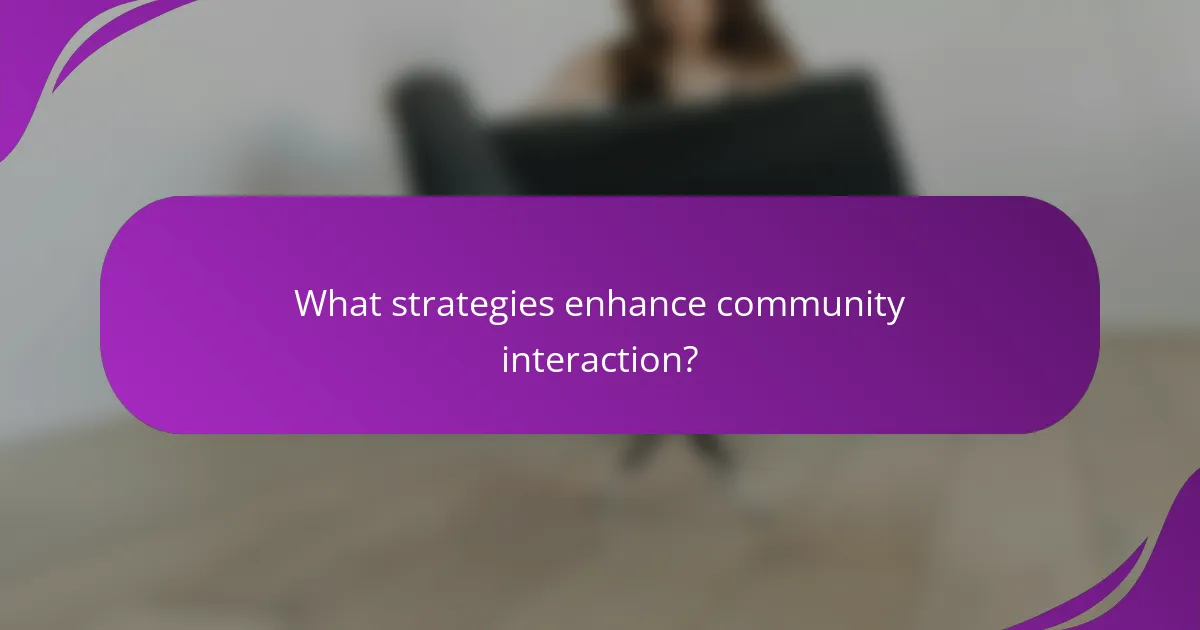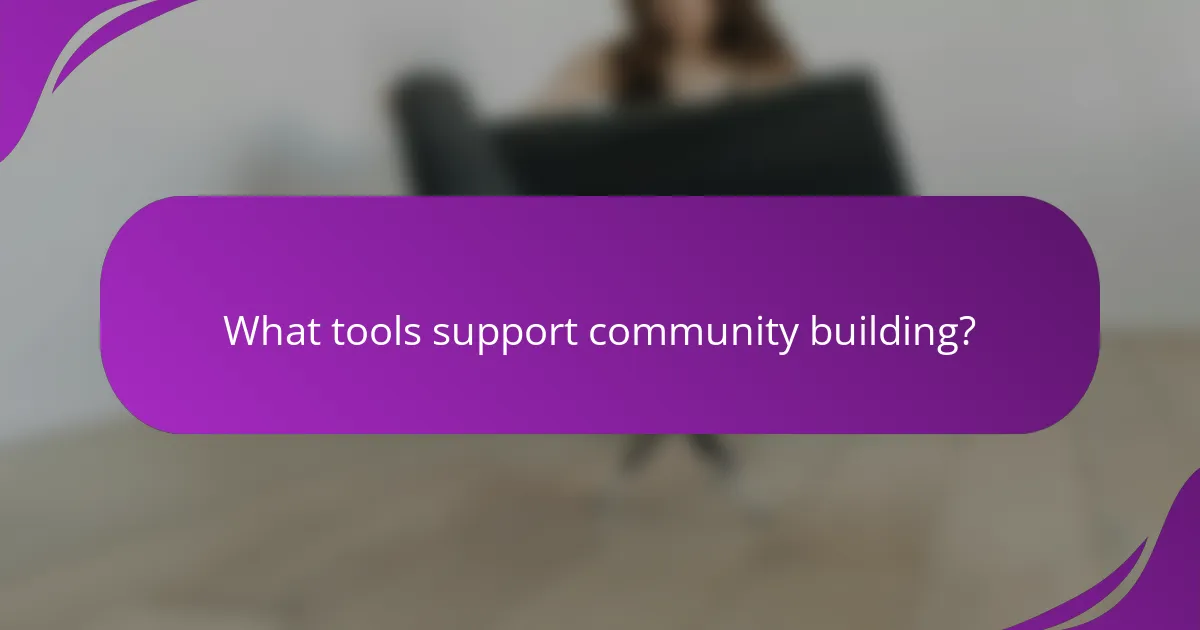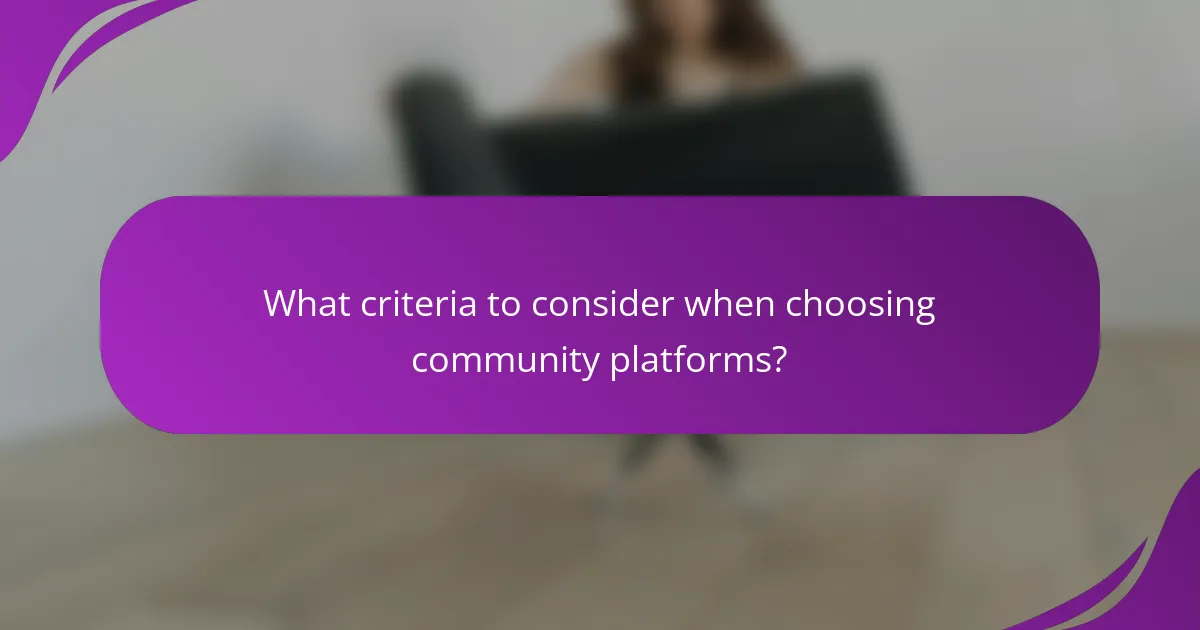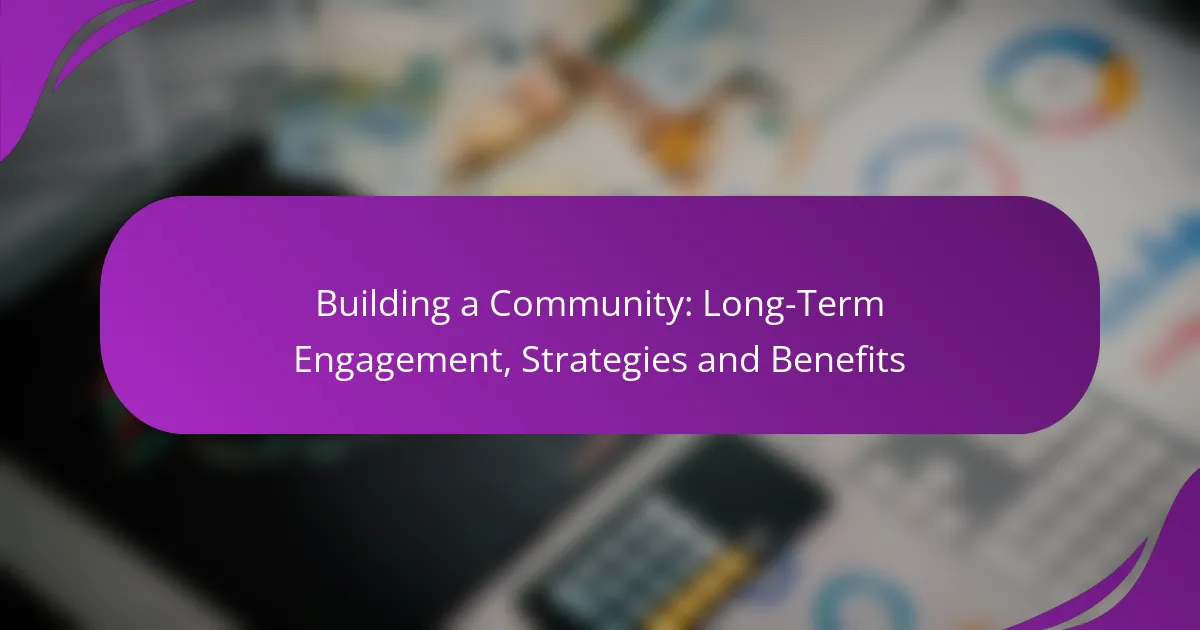Building a thriving community requires a focus on long-term engagement and meaningful connections among members. By strategically utilizing digital platforms and fostering regular interactions, organizations can encourage active participation and contributions. This approach not only enhances community interaction but also leads to increased loyalty and valuable feedback, ultimately driving long-term success.

How to build long-term community engagement in Canada?
Building long-term community engagement in Canada involves creating meaningful connections and fostering ongoing participation among members. This can be achieved through strategic use of digital platforms, regular interactions, and encouraging contributions from community members.
Utilize online forums and social media
Online forums and social media platforms are essential tools for fostering community engagement. They provide spaces for members to share ideas, ask questions, and connect with one another. Consider using popular platforms like Facebook, Twitter, and Reddit to create dedicated groups or threads focused on specific topics relevant to your community.
Engagement can be enhanced by regularly posting updates, responding to comments, and facilitating discussions. Aim to post at least a few times a week to keep the conversation active and encourage participation from all members.
Host regular virtual events
Regular virtual events, such as webinars, Q&A sessions, or workshops, can significantly boost community engagement. These events allow members to interact in real-time, share knowledge, and build relationships. Schedule events monthly or quarterly to maintain interest and provide consistent opportunities for participation.
Promote these events through your online platforms and consider using tools like Zoom or Microsoft Teams for hosting. Ensure to gather feedback after each event to improve future sessions and better meet the needs of your community.
Implement gamification strategies
Gamification can enhance engagement by making participation fun and rewarding. This can include point systems, badges, or leaderboards that recognize active members. For example, you might reward users for contributing content, participating in discussions, or attending events.
Consider setting clear goals and rewards that resonate with your community’s interests. This approach not only encourages participation but also fosters a sense of achievement and belonging among members.
Encourage user-generated content
Encouraging user-generated content (UGC) can deepen community ties and increase engagement. Invite members to share their experiences, stories, or expertise through blog posts, videos, or social media posts. This not only enriches the community but also empowers members to take an active role in its development.
To facilitate UGC, create clear guidelines and provide prompts or themes that inspire contributions. Highlight and celebrate member submissions to motivate others to participate and share their voices within the community.

What strategies enhance community interaction?
Effective strategies for enhancing community interaction include utilizing technology and building relationships. By leveraging community management tools and partnering with local influencers, organizations can foster deeper engagement and create a vibrant community atmosphere.
Leverage community management tools
Community management tools streamline communication and facilitate interaction among members. Platforms like Discord, Slack, or Facebook Groups allow for real-time discussions, event planning, and resource sharing, making it easier for members to connect and collaborate.
When choosing a tool, consider the specific needs of your community. For instance, if your audience is younger, platforms like Discord may be more appealing, while professional groups might prefer LinkedIn or Slack. Regularly assess the effectiveness of the tools and adjust as needed to keep engagement high.
Foster partnerships with local influencers
Partnering with local influencers can significantly boost community interaction by leveraging their established audiences. Influencers can help promote events, share content, and encourage participation, making your community more visible and attractive to potential members.
To identify suitable influencers, look for individuals who align with your community’s values and interests. Engage them through personalized outreach, and consider offering incentives such as exclusive access to events or products. This collaboration can create a win-win situation, enhancing both the influencer’s and the community’s visibility.

What are the benefits of a strong community?
A strong community fosters deeper connections between members and the brand, leading to numerous advantages. These benefits include increased customer loyalty, enhanced brand visibility, and access to valuable feedback, all of which contribute to long-term success.
Increased customer loyalty
Building a community around your brand can significantly boost customer loyalty. When customers feel a sense of belonging, they are more likely to remain loyal and make repeat purchases.
Engagement strategies such as exclusive events, loyalty programs, and personalized communication can strengthen these bonds. For instance, offering members-only discounts can encourage ongoing patronage.
Enhanced brand visibility
A vibrant community can amplify your brand’s visibility through word-of-mouth and social sharing. Members often share their positive experiences, which can attract new customers.
Utilizing social media platforms to showcase community interactions can enhance this effect. Regularly featuring user-generated content can create a sense of authenticity and encourage further engagement.
Access to valuable feedback
Communities provide a direct line to customer opinions and suggestions, which can be invaluable for product development and service improvements. Engaging with community members allows brands to gather insights that may not be captured through traditional surveys.
Consider implementing feedback loops, such as polls or discussion forums, to facilitate open dialogue. This approach not only helps in refining offerings but also makes customers feel valued and heard.

What tools support community building?
Effective community building relies on various tools that facilitate communication, collaboration, and engagement. Choosing the right platform can enhance interaction and foster a sense of belonging among members.
Discord for real-time communication
Discord is a popular platform for real-time communication, particularly among gaming and tech communities. It allows users to create servers where members can chat via text, voice, or video, enabling immediate interaction.
When using Discord, consider setting up different channels for various topics to keep conversations organized. This can help prevent information overload and ensure that members can easily find discussions relevant to their interests.
To maximize engagement, encourage members to participate in voice chats or live events, which can create a more dynamic community atmosphere. Regularly scheduled events can keep the community active and engaged.
Slack for collaboration
Slack is designed primarily for workplace collaboration but is also effective for community building. It offers channels for specific topics, direct messaging, and integration with various productivity tools, making it easy for members to collaborate on projects.
Utilize Slack’s features like threads to keep discussions organized and focused. This can help prevent important messages from getting lost in a busy channel. Consider creating dedicated channels for different projects or interests to cater to diverse member needs.
To enhance collaboration, encourage members to share resources and updates regularly. This can foster a sense of teamwork and keep everyone informed about ongoing activities within the community.
Facebook Groups for engagement
Facebook Groups provide a familiar platform for community engagement, allowing members to share posts, comment, and interact with each other. This platform is particularly useful for reaching a broader audience due to its extensive user base.
When creating a Facebook Group, set clear guidelines to maintain a positive environment. Regularly post engaging content, such as polls or questions, to encourage participation and keep discussions lively.
Consider using Facebook’s event feature to organize meetups or online gatherings. This can strengthen community bonds and encourage members to connect beyond the digital space.

What criteria to consider when choosing community platforms?
When selecting community platforms, consider user demographics, integration capabilities, and scalability options. These factors significantly impact the platform’s effectiveness in fostering long-term engagement and meeting your community’s needs.
User demographics
User demographics refer to the characteristics of your target audience, such as age, location, interests, and online behavior. Understanding these factors helps in choosing a platform that aligns with where your audience is most active. For instance, younger users may prefer platforms like Discord or TikTok, while professionals might lean towards LinkedIn or specialized forums.
Analyze existing community data or conduct surveys to gather insights about your audience. This information will guide you in selecting a platform that not only attracts users but also encourages participation and interaction.
Integration capabilities
Integration capabilities determine how well a community platform can connect with other tools and services you use. Look for platforms that support integrations with social media, email marketing, and customer relationship management (CRM) systems. This connectivity enhances user experience and streamlines community management.
For example, a platform that integrates with tools like Slack or Zoom can facilitate real-time communication and virtual events, enriching the community experience. Always check for available APIs and third-party integrations before making a decision.
Scalability options
Scalability options refer to a platform’s ability to grow alongside your community. Choose a platform that can handle increasing user numbers and engagement levels without compromising performance. This is crucial for maintaining a positive user experience as your community expands.
Consider platforms that offer tiered pricing or features that can be unlocked as your community grows. For instance, some platforms may start with basic features for small groups and offer advanced functionalities for larger communities. Evaluate your long-term goals to ensure the platform can accommodate future needs.
